ABSTRACT
Plants are a considerable source of active substances which are exploited in the treatment of several diseases, among which are rheumatic affections. This study aimed to explore the knowledge of traditional practitioners and patients on medicinal plant species of Ouagadougou, Burkina Faso, used for the treatment of rheumatic affections. Direct interviews with open-ended and closed-ended questionnaires were used to collect information on ethnopharmacological uses of plants among 50 traditional practitioners and 125 patients of the Department of Rheumatology, CHU-Yalgado Ouédraogo. Majority of the traditional practitioners were male (70%) and their average age was 56.42 years. 74% of traditional practitioners had non-formal education and their knowledge on rheumatic affections was limited. A total of 73 medicinal plants belonging to 70 genera in 41 families were cited as being important for the treatment of rheumatism by traditional practitioners. Among the families, Caesalpiniaceae, Combretaceae, Meliaceae, Fabaceae, Euphorbiaceae, Rubiaceae and Apocynaceae were the most represented and root dominated by 52% over other plant parts used as herbal remedies. Plants were used alone or in association with other plants or ingredients. The decoctions were more recommended and administered through oral and topical routes. Majority of the interviewed patients were female (73%) and half of the patients used a traditional treatment in rheumatic affection. The oral route was the advantaged mode of administration of remedies (55.7%) and approximately 10% of the patients considered that the side effects or the interactions between conventional medicine and healing plants were absent. Traditional practitioners are widely involved in the care of rheumatic affections in Ouagadougou. This is the first record on traditional practitioners’ knowledge on plants used for the treatment of rheumatism in this area. Investigations have to continue to justify the empirical use of these plants and to obtain essays of medicinal formulations.
Key words: Rheumatic affections, medicinal plants, traditional practitioners, Ouagadougou.
Since the origin of human civilization, humans have found remedies within their habitat and have adopted different therapeutic strategies depending on climatic, phyto-geographic, sociocultural, floral, and faunal characteristics (Eddouks et al., 2012). Traditional medicine is an important and often underestimated part of health care. It is found in almost every country in the world and the demand for its services is increasing. Traditional medicine, with proven quality, safety and efficacy, contributes to the goal of ensuring that everyone has access to care (WHO, 2013). The rich history of African cultures and their innovative utilization of plants as a source of remedies have been passed down through generations largely by oral tradition (Soelberg et al., 2015). In Burkina Faso, traditional medicine is used in the treatment of many diseases. The national-scale analysis revealed systematic patterns of traditional plants used throughout the country. So, out of the 2067 known plant species of Burkina Faso, 1033 (50%) had a recorded traditional use (Zizka et al., 2015). Rheumatic diseases are disorders of connective tissue, especially the joints and related structures, characterized by inflammation, degeneration or metabolic disorder. In the community, rheumatic diseases account for a larger loss of working days than accidents, heart disease and infections. The problem of rheumatic disability is even more pronounced in those participating in hard manual labor where the integrity of the musculoskeletal frame is important (Bird et al., 1985). Burkina Faso economy is strongly dominated by agriculture which uses about 80% of the working population. As a result, time lost from work because of rheumatic diseases is a considerable drain on the economy of this country. The present study aims to gather all the information concerning the knowledge and the practices of the traditional practitioners (TP) of Burkina Faso regarding rheumatic affections and to establish a catalog of healing plants used in the treatment of these affections to improve the traditional in-care of rheumatic affections.
Study area
Ouagadougou, situated in the central plateau (12° 21’58’’ N 1.31’05’’ W) is the capital town of Burkina Faso. It has an area of 2,805 km2 and it has a population of 2.5 million (2015). The climate of Ouagadougou is hot semi-arid under Köppen-Geiger classification, that closely borders with tropical wet and dry. The city is part of the Sudano-Sahelian area, with a rainfall of about 800 mm per year. The rainy season stretches from May to October, it peaks from June to September, with a mean average temperature of 28°C. The cold season runs from December to January, with a minimum average temperature of 16°C. The maximum temperature during the hot season, which runs from March to May, can reach 43°C. The harmattan and the monsoon are the two main factors that determine the climate in Ouagadougou. Even though Ouagadougou is farther from the equator, the temperatures of its hottest months are slightly high. The main languages spoken are French, mooré, dioula and fulfuldé.
Data collection and plants identification
The data were collected with the TP of Ouagadougou appearing on the directory of the TP set up by the Direction of the Traditional Medicine and the Pharmacopeia (DMPT) of Burkina Faso as well as with patients seen at consultation in the service of Rheumatology of the CHU-YO. The objectives of the study were first revealed to the interviewees after informed consent, then an open and closed questionnaire was administered. The answers were directly transcribed on the index cards. The questionnaire was structured in seven sections: i) identification of the TP; ii) organization of the work of management of patients; iii) diagnosis of the rheumatic affections; iv) treatment of the rheumatic affections; v) identification of the patient; vi) use of medicinal plants; vii) information of the rheumatologist on the use of medicinal plants. The identification of the plant was performed using its mooré names given by the TP.
Data analysis
The answers to the open questions were compiled to measure the reserved variables. The closed questions were treated by the software Epi Info3.5.1. and Excel 2010.
Identification of the traditional practitioners
The socio-demographic characteristics of the TP were analyzed using the following variables: gender, age groups, educational status, religion, number of years of practice, major occupation and the mode of acquisition of knowledge in the study area (Table 1). Fifty TP were interviewed in this study and male respondents dominated this population (70%). This situation is better explained by the hereditary character of the transmission of healing power. As the sons succeed their fathers in the management of the family business, the secrets of the family are thus transmitted to them. The profession of traditional practitioner confers notoriety. The greater respect for men could be due to the fact that they treat more health problems or very often also use spiritual powers for diagnosis or treatment, whereas women more often have mainly herbalistic knowledge. In the African societies, this status suits men most (Gessler et al., 1995) accounting for the male ascendancy found in the current study and many other studies (Ogunkalu et al., 2017; Gessler et al., 1995; Ould, 2009). But this transmission of healing power and ancestral knowledge occurs in adult life, thus, justifying the average age of the TP of this study which was 56.42 years.
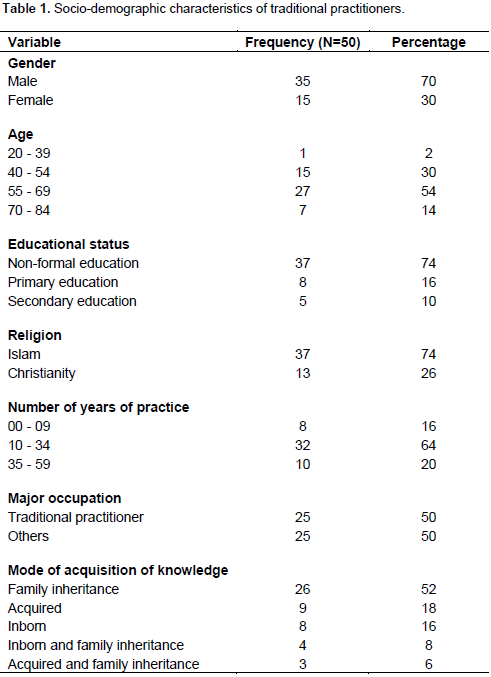
It was observed that the level of education of the majority of the TP in the study area was relatively low (74% non-formal education). The same observation has been reported by Thiane (2004) and Kroa et al. (2014), respectively in Senegal and Côte d’Ivoire. This can be attributed to the low schooling rate in sub-Saharan Africa in general and in Burkina Faso in particular. In addition, in the current study and that of Ogunkalu et al. (2017), these groups of traditional healers did not feel the need for formal education because they believed that the knowledge of traditional healing is cultural, instinctive, inherited, innate and spiritual and hence requires no education. Seventy-four percent of the TP were Muslim. This is consistent with the fact that the Islam is the main religion of Burkina Faso (CNLS-IST, 2016). Although, more than half questioned practitioners asserted having another activity, they were solidly established as suppliers of care in numerous communities. The average period of practice of the investigated TP was 23.48 years: they were thus experienced professionals. These might be explained by the fact that most are engaged in this job up to an advanced age and that their expertise was passed on to them during their adulthood by a member of their family.
Knowledge of TP on rheumatic affections
All the TP of the current study had some knowledge on rheumatic affections. Their information based on symptoms and complications is detailed in Table 2. Regarding the symptoms of rheumatic affections, all the TP only mentioned the joint and osseous pains which can affect the back, hips, knees and other parts of the body. However, the precision of the time of appearance of these pains or the triggering factor helps to classify various rheumatic affections in "mechanical" or "inflammatory" pathology. Just like the symptoms, the problem of nosology also settled at the complications level of the rheumatic affections. According to the criteria of modern medicine, the complications of the rheumatic affections lead to an involvement of the vital organs (heart, lungs, kidney and liver) (Prescott, 2013). These complications were not mentioned by the TP because this infringement is only detectable by medical examinations that the TP cannot identify.
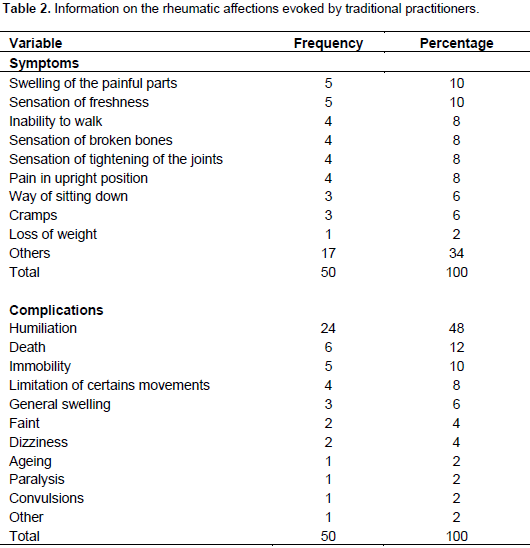
Botanic characteristics of plants used in the treatment of the rheumatic affections
This study identified 73 medicinal plants belonging to 70 genera in 41 families for treatment of rheumatism. Detail on the number of cited plants from the respective of plant family is presented in Figure 1. Table 3 belows shows the ten most used plants in the treatment of rheumatic affections by the TP and Saba senegalensis is the most reported. Figure 2 shows the part of the plants used in the treatment of rheumatic affections. The best represented families were Caesalpiniaceae, Combretaceae, Meliaceae, Fabaceae, Euphorbiaceae, Rubiaceae and Apocynaceae. In fact, these various families greatly contribute to the flora of Burkina Faso (Zizka et al., 2015). All parts of the plant are used in the fresh or dry state: roots, leaves, barks of the trunk, fruits, flowers and seeds. Roots were the parts of the plant preferentially used. The use of root or whole plant and the frequent use of seeds or fruit for the preparation of medicines have destructive effects on the growth of plants population in nature (Ghimire et al., 2008).
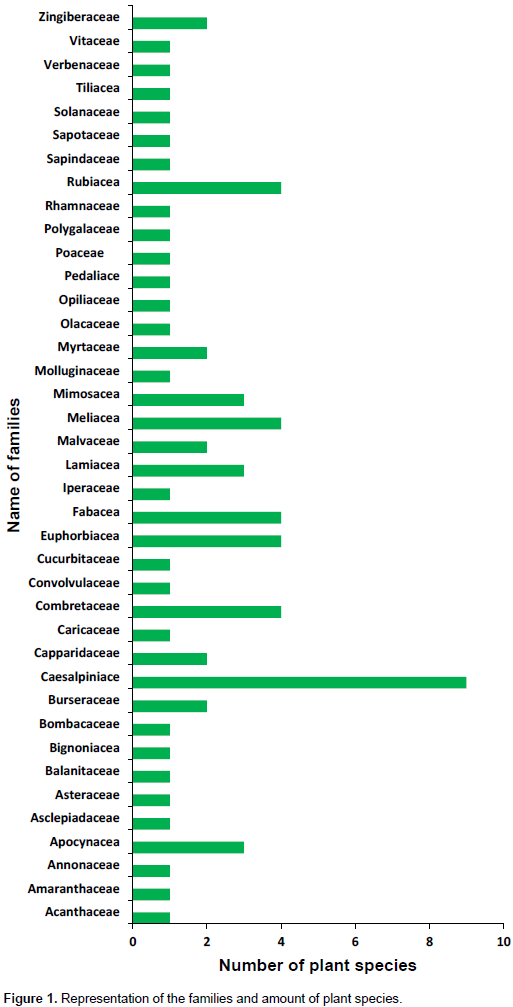
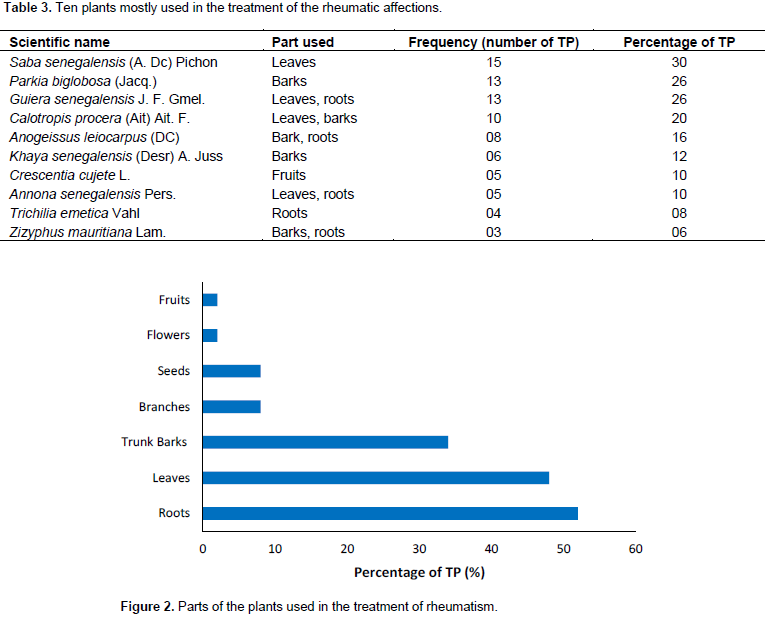
Ethnopharmacological survey
The most quoted medicinal plants by the TP during the investigation were used alone or in association with the treatment of rheumatic affections. 81 recipes were listed and water was the only solvent of extraction of these remedies. The methods of preparation of the plants are summarized in Figure 3 and decoction was the most used. Shea butter was the most frequently used excipient in the remedies as shown in Table 4. Some recipes are recorded in Table 5. The TP prepared the recipes themselves in 56% of the cases. This attitude guarantees the quality of remedies, the respect for the quantities of raw materials and the setting-up time. The traditional medication includes medicinal plants, human parts, animal parts and minerals but plants are the most important part of the traditional therapeutic armamentarium. Decoctions were the most frequently used forms, followed by powders, infusions and macerations. Decoctions have a shorter shelf-life than some powders which stay longer because they are dry forms. The absence of preservative agents in decoctions would limit their shelf life. In this study, all TP claimed that their remedies had neither side effects nor contraindications for pregnant women and children. This could be explained by the fact that bath and massage were the most frequently used modes of administration, besides the oral form. But these assertions must be checked, because these quoted plants are especially used for their anti-inflammatory properties. However, the main side effect of anti-inflammatory drugs, in particular, non-steroidal anti-inflammatory (NSAI) on peptic ulcers may be fatal complications (Drini, 2017). Moreover patients need to be informed and be aware of potential serious adverse effects (Drini, 2017).
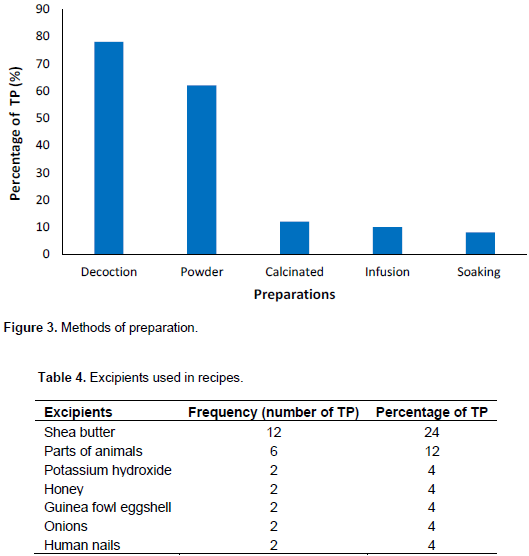
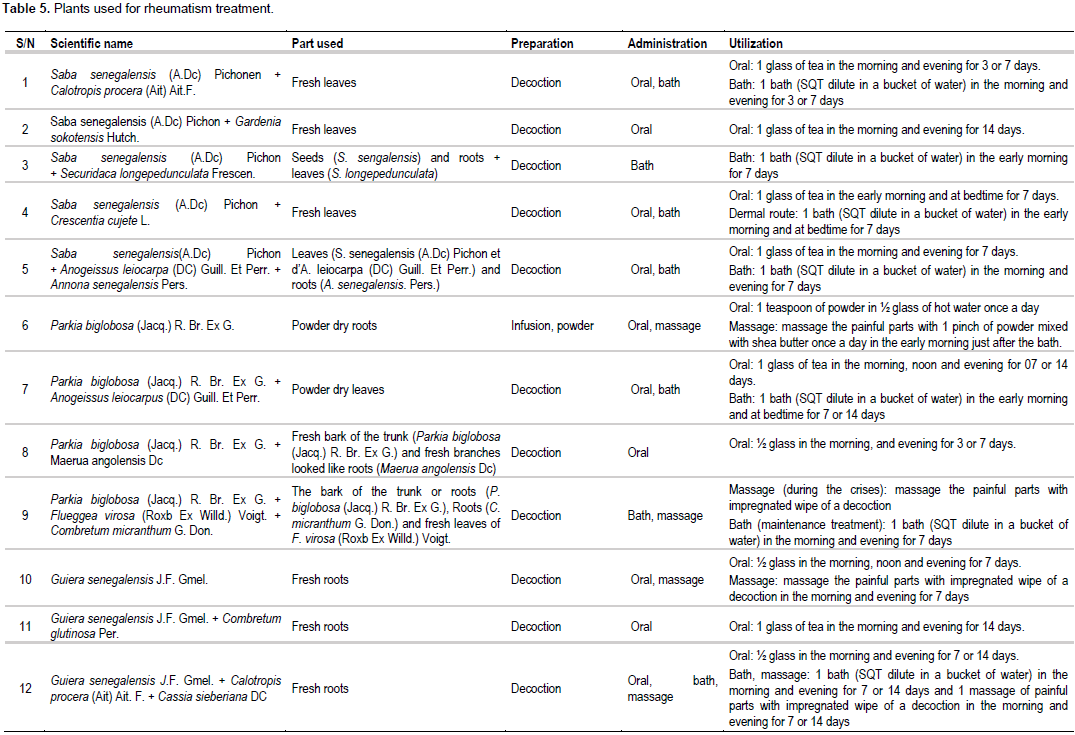
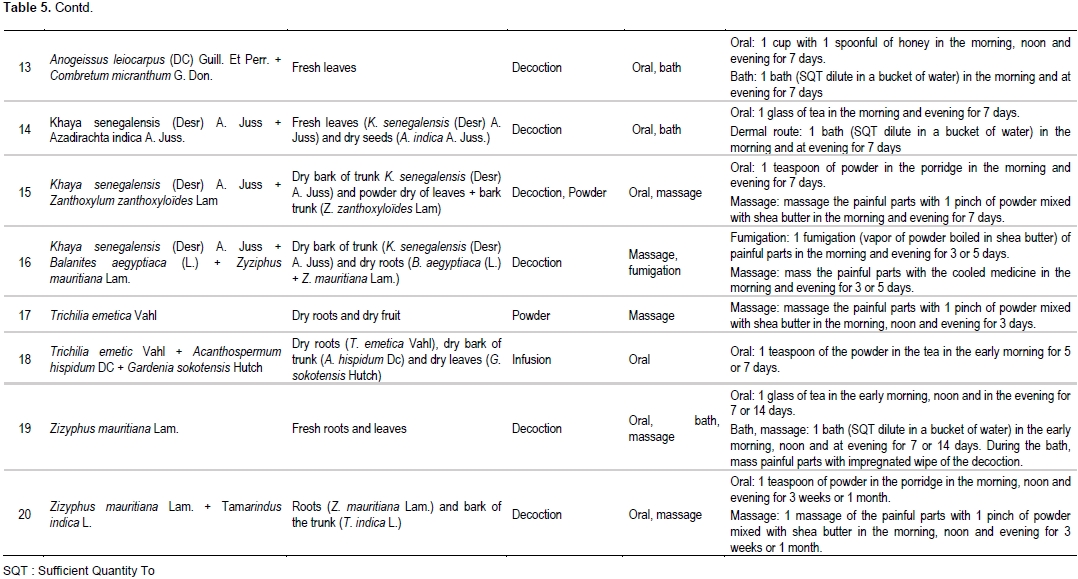
Identification of the patients
The study was performed in the Department of Rheumatology, CHU, Yalgado Ouedraogo involving 125 patients who had come in consultation. Sociodemographic characteristics of patients are summarized in Table 6 below. Attitudes and practices of patients related to medicinal plants have also been investigated and presented in Table 7. Majority of the patients seen in the Rheumatology Department during the study were females (73%) and the age range is 45 to 60 years and 30 to 45 years were the most represented. Although, the relationship between the occurrence of the rheumatic affections and the gender remains unknown, there is a large consensus that adult women consult more in the service of rheumatology (Carapetis et al., 2005). Half of the interviewees used a traditional treatment in rheumatology affection. This could be due to the efficiency of these plants when the main purpose of their use is to reduce the symptoms and not cure (Rao et al., 1999). In this study, 77% of the patients were informed about the utility of healing plants by their families or friends. Indeed, in Burkina Faso, there is in every geographical region, a familial self-medication, based on the TP. The danger to the population is that some retailers amplify the therapeutic indications of plants, do not mention the precautions for their use and do not know their side effects and toxicity. The prevalent mode of administration of remedies for patients was drink (55.7%). This is in accordance with the results found for TP of the current study. All the patients who used medicinal plants did not inform their rheumatologists on the use of medicinal plants. Information on the traditional medicine should be included in routine consultation for a better global coverage of the patient. In a study in USA, almost half of the patients who used medicinal plants in rheumatology affections informed their rheumatologist for fear of the side effects (Rao et al., 1999). In this study, approximately 10% of the patients considered that there were no side effects or interactions between conventional medicine and healing plants. The same proportion was reported in the study of Hmamouchi et al. (2012) on the traditional use of Moroccan healing plants in rheumatology.
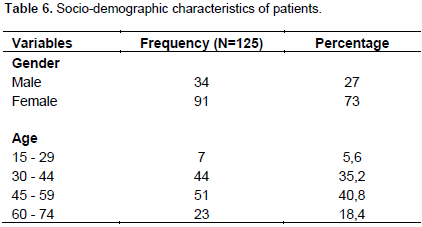
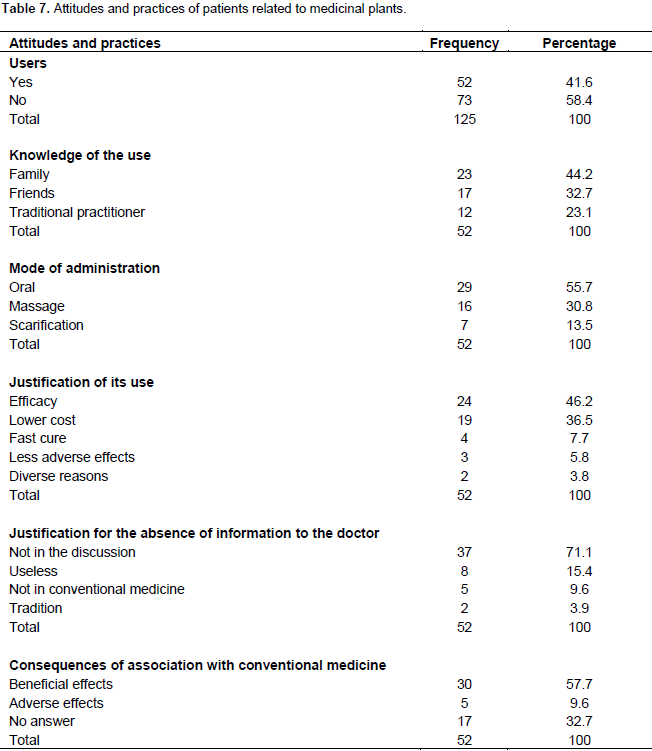
This study among the TP and patients of Rheumatology Department showed that healing plants are widely used by these patients for traditional care of rheumatic affections. This study revealed that majority of the TP acquired their knowledge through inheritance from their parents, and the symptoms and the complications of the rheumatic affections were not very well known by them. It is also observed from this study that TP use mainly the roots of plants to prepare remedies, thus, it is crucial to cultivate and protect these species. An important proportion of people who are going to consult at the hospital have used, besides medical treatment, the traditional medicine. They do not inform their doctor who, otherwise, could have warned them of the few known interactions between the allopathic drugs and traditional medicine. The rheumatologists should thus always consider the possible use of traditional medicine by their patient. Considering the high proportion of patients taking both types of drugs and the poor knowledge on the interactions between plants and allopathic drugs, the mechanisms of action and the possible side-effects of the active substances of these plants should be extensively studied in order to propose safe treatments.
The authors have not declared any conflict of interests.
The authors thank the Directorate General for Pharmacy, Drug and Laboratories (DGPML) of Burkina Faso, for the use of a directory of the TP as well as all the TP and the patients who took part in the study.
REFERENCES
|
Bird HA, Le Gallez P, Hill J (1985). Combined care of the rheumatic patient. Springer- Verlag berlin Heidelberg. P 2.
Crossref
|
|
|
|
Carapetis JR, Steer AC, Mulholland EK, Weber M (2005). The global burder of group A streptococcal diseases. Lancet Infect Dis. 5(11):685-694.
Crossref
|
|
|
|
CNLS-IST (2016). Rapport d'activité sur la riposte au sida au Burkina Faso. GARP. P 7.
|
|
|
|
Drini M (2017). Peptic ulcer disease and non-steroidal anti-inflammatory drugs. Austr. Prescr. 40(3):91-93.
Crossref
|
|
|
|
Eddouks M, Chattopadhyay D, De Feo V, Cho WC (2014). Medicinal plants in the prevention and treatment of chronic diseases 2013. Evid. Based Complement Altern. Med. pp. 1-3.
Crossref
|
|
|
|
Gessler MC, Msuya DE, Nkunya MHH, Schär A, Heinrich M, Tanner M (1995). Traditional healers in Tanzania: sociocultural profile and three short portraits. J. Ethnopharmacol. 48:145-160.
Crossref
|
|
|
|
Hmamouchi I, Mouna R, Ezzahra F, Khazzani H, Bennani L, Bzami F, Mansouri L, Tahiri L (2012). Use of moroccan herbal products among patients of rheumatology. Rev. Mar Rhum. 22:52-56.
|
|
|
|
Kroa E, Diaby B, Niaré A, Traoré Y, Ahoussou EM, Yao GHA, Coulibaly GS, Kouassi D (2014). Analyse de la collaboration entre médecines traditionnelle et moderne dans la région du Sud Bandama (Côte d'Ivoire). Revue CAMES–Série Pharm. Méd. Trad. Afr. 17(1):21-27.
|
|
|
|
Ogunkalu OA, Sodimu AI, Suleiman RA, Oni BO, Otiwa GI (2017). Ethno medicinal survey of plants used for the treatment of rheumatism in Kajuru Local Government Area of Kaduna State, Nigeria. World Scientific News 80:43-56.
|
|
|
|
Ould M (2009). Contribution to study of the medicinal plants of Mauritania. Tome XVII. Série sciences. Université de Lomé (Togo). 27:11.
|
|
|
|
Prescott SL (2013). Early-life environmental determinants of allergic diseases and the wider pandemic of inflammatory noncommunicable diseases. J. Allergy Clin. Immunol. 131(1):23-30.
Crossref
|
|
|
|
Rao JK, Mihaliak K, Kroenke K, Bradley J, Tierney WM, Weinberger M (1999). Use of complementary therapies for arthritis among patients of rheumatologists. Ann. Int. Med. 409:131.
Crossref
|
|
|
|
Soelberg J, Asase A, Akwetey G, Jäger AK (2015). Historical versus contemporary medicinal plant uses in Ghana. J. Ethnopharmacol. pp. 160:109-132.
|
|
|
|
Thiane FM (2004). Connaissance de l'Epilepsie, attitude et pratique des tradipraticiens de Dakar. Thèse de doctorat en Pharmacie. Université Cheikh Anta Diop de Dakar 95:1-43.
|
|
|
|
World Health Organization (WHO) (2013). WHO traditional medicine strategy: 2014-2023. WHO Library Cataloguing-in-Publication Data. P 7.
|
|
|
|
Zizka A, Thiombiano A, Dressler S, Nacoulma B, Ouédraogo A, Ouédraogo I, Ouédraogo O, Zizka G, Hahn K, Schmidt M (2015). Traditional plant use in Burkina Faso (West Africa): a national-scale analysis with focus on traditional medicine. J. Ethnobiol. Ethnomed. 11:9.
Crossref
|